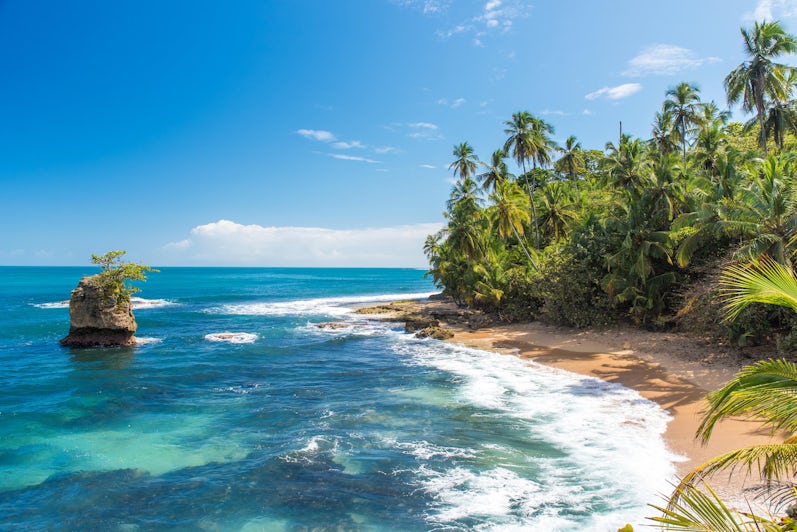
Windstar vs. Lindblad Expeditions-National Geographic in Costa Rica


Costa Rica is an ecotourist's paradise, and an ideal destination for a small-ship cruise. The region is one of the most bio-diverse in the world, with opportunities to see exotic wildlife on land and in the water. Combine that with beautiful beaches, water sports from snorkeling to kayaking, active land pursuits like hiking and ziplining and ports inaccessible to large cruise ships, and active travelers can revel in a unique cruise getaway.
Many cruise lines stop in Costa Rica and Panama -- and many transit the Panama Canal -- but not many offer entire seasons exploring Costa Rica's Pacific Coast because their ships are simply too big. Windstar Cruises and Lindblad Expeditions-National Geographic are two of the small-ship lines that offer cruisers the chance to immerse themselves in this Central American destination, combined with a full crossing of the Panama Canal.
While both cruise lines visit roughly the same areas of Costa Rica and Panama, their trips and ships are markedly different. Windstar offers more of a typical cruise experience, with plenty of creature comforts and choice in what you do in port, but with onshore experiences priced a la carte. Lindblad is an expedition line and takes a more nature-based approach to the journey, with all excursions ashore and at sea included in your fare, and staffs its ships with expert naturalists and photographers.
If you're looking for an off-the-beaten-path getaway in Costa Rica and a bucket list transit of the Panama Canal, we compare Windstar vs. Lindblad Expeditions-National Geographic's cruises.
Itinerary and Shore Excursions
Both cruise lines offer weeklong sailings to Costa Rica and the Panama Canal. Windstar's cruises sail one-way between Puerto Caldera, Costa Rica and Colon, Panama (or vice versa). The ship calls at Quepos (close to Manuel Antonio National Park); Bahia Drake (near Corcovado National Park); Bahia Herradura, home to the pristine, non-touristy beach of Playa Herradura; Golfo Dulce, a sheltered bay dividing the Osa Peninsula from the mainland; Isla Parida in Panama for a beach and water sports day; Panama's Pearl Islands, which offers renowned snorkeling and scuba diving; and Fuerte Amador, the port for Panama City. (Smaller ports vary, based on the cruise length.)
In many ports, passengers journey to shore in inflatable Zodiacs, which can be tricky for people with mobility issues. Unless you opt for private tours, you will be booking large group excursions through the ship. Shore excursions cost extra, often between $80 and $250, and may include nature walks, dolphin watches, boat rides to see wildlife, kayaking or snorkeling.
The ship cruises the Panama Canal during the day, usually beginning between 7 and 8 a.m. Windstar does offer tours to the canal and its visitor center during the call in Fuerte Amador, so if you want a more in-depth look at the locks or see the wildlife in the Gatun Lake area, you will need to book a ship-sponsored or independent excursion.
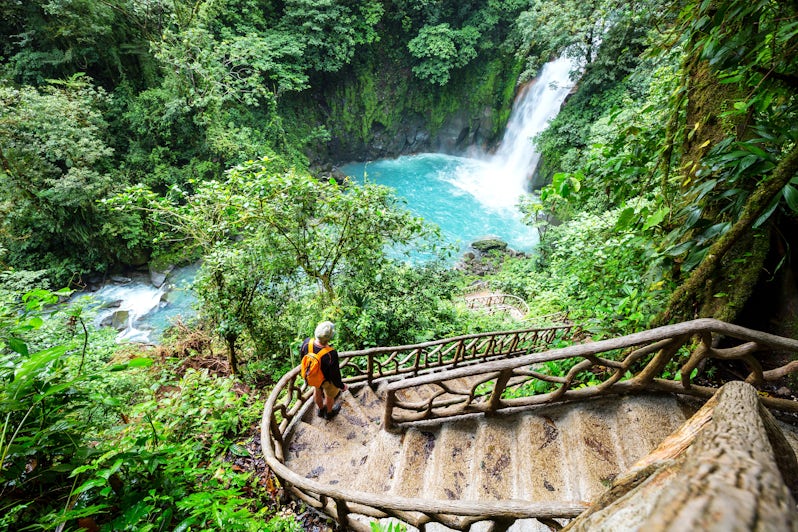
For Lindblad Expeditions, the focus is really on getting into Costa Rica's forests and sea, with an emphasis on active exploration. Its cruises, which also run between Puerto Caldera and Colon, call at Corcovado National Park, Golfo Dulce, Coiba National Park and tiny inlets in the Gulf of Panama. The ship will overnight at Barro Colorado Island in Gatun Lake, a wildlife research site, with guided walks through the forest during the day. That evening, the ship will continue through the canal out to the Caribbean. All water sports and visits to national parks and other attractions (like the Casa Orquideas botanical garden) are included in the fare. The itinerary is very active, with hikes for multiple levels and water-based, naturalist-led expeditions in either kayaks or landing crafts in various destinations.
Choose Windstar if: You want a lot of choice in how you spend your day, either onboard or onshore, and don't mind spending extra for tours, or if you want to spend more time relaxing on a beach.
Choose Lindblad if: You are fascinated by nature and wildlife, and want a really unique experience in the Panama Canal that focuses on biodiversity as well as engineering.
Ships

Windstar employs one of its 212-passenger yachts, Star Breeze, as well as one of its sailing ships, Wind Star, which has a capacity for only 148 passengers, on Costa Rica and Panama Canal itineraries through 2020.
Both ships offer a spacious Yacht Club lounge, where enrichment seminars, live music and other day-to-day activities are held (the venue also houses a bar and coffee counter); a marina with water sports equipment; a saltwater pool and hot tub; various bars and indoor/outdoor restaurants; a spa; a fitness center; and a library/computer room, among other features. Star Breeze offers additional dining options and entertainment space.
The marina is stocked with kayaks, pedal boats and standup paddleboards as well as motorized water toys, put in use when the weather permits. Passengers enjoy an upscale cruise experience and personalized service from a large crew.
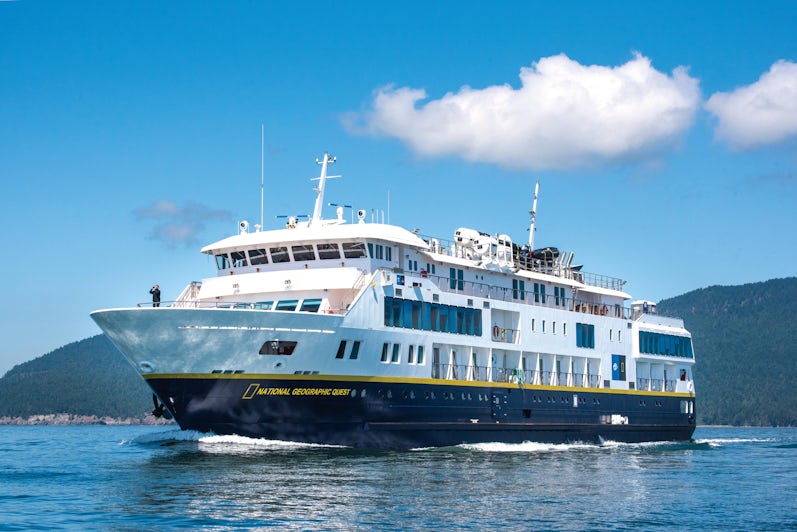
Lindblad Expeditions uses the 100-passenger National Geographic Quest on cruises through 2020.
The four-deck ship has one main, very functional lounge with a bar and library area, used for socializing and enrichment talks; a sun deck, which doubles as an observation deck; and a small fitness center and one-room spa with a limited menu of options. High-tech features include an underwater remote-operated vehicle (ROV), video microscope, hydrophone and splash cam. The ship carries walking sticks, snorkeling equipment, standup paddleboards, kayaks and Zodiacs. Naturalists, photo instructors and guest lecturers lead excursions, give talks and help passengers get the most from their sailing. The ship is comfortable but minimalist, more of a mode of transport than a place you'd want to hang out in rather than be ashore.
Choose Windstar if: You're looking for a traditional luxurious cruise experience on a smaller ship. It's the best for people who might want to spend some time onboard and enjoy creature comforts and onboard amenities.
Choose Lindblad if: Your focus is on the destination, and you don't really mind the limited options of an expedition ship, such as smaller, bare-bones cabins and minimal dining options.
Cabins
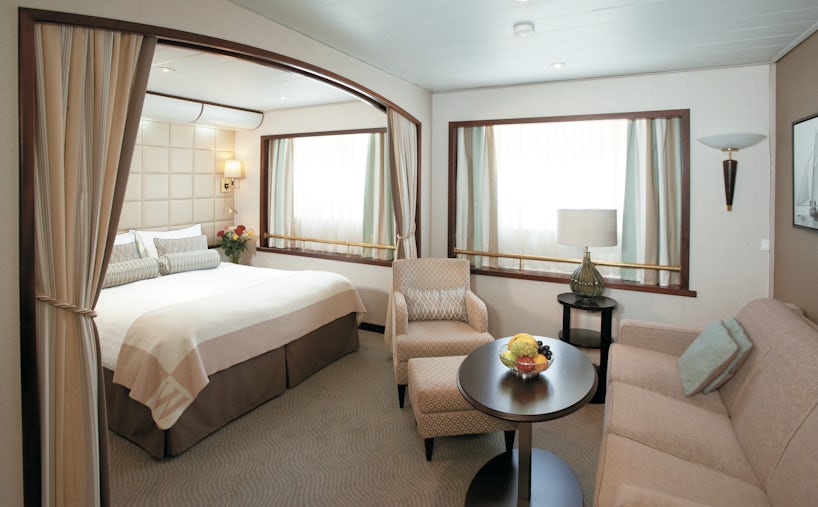
If you want a cozy home-away-from-home, Windstar's Star Breeze offers spacious cabins and suites, ranging from 277 to 575 square feet. All are suites with windows; some have French balconies or true balconies. Cabins feature separate sleeping and living areas, beds that convert from twins to queens, comfortable couches and chairs, walk-in closets, minibars, and large marble bathrooms with double sinks, a shower/tub combo and L'Occitane bath products.
Meanwhile, all of Wind Star's 73 cabins are identical, with 188 square feet and two small porthole windows. There's one 220-square-foot Owner's Suite, also with a view window (no balcony). Bathrooms feature showers and L'Occitane bath products.
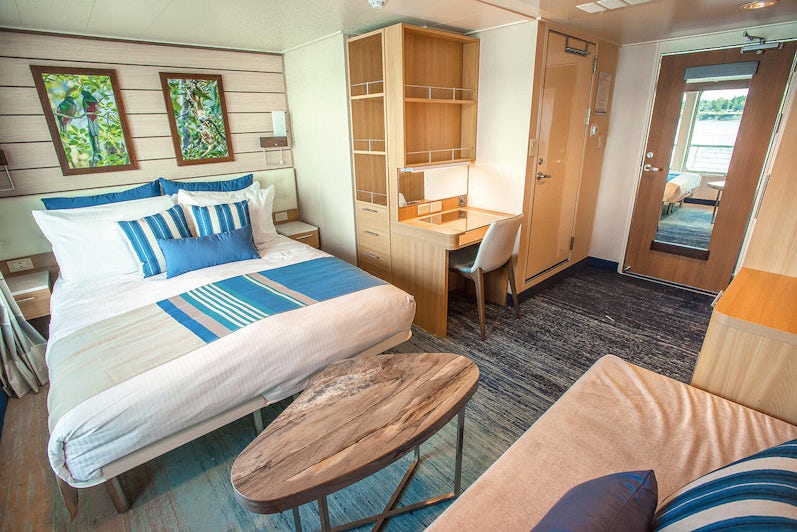
Lindblad, on the other hand, takes a more utilitarian approach to cabins on Quest. Cabins -- divided among five categories -- are small, ranging from 136 to 185 square feet, but offer ample storage space. Bathrooms feature botanical refillable gel dispensers in lieu of single-use plastic bottles. Only one category of cabins has balconies; there are no TVs or mini-bar/fridges in any of the cabins.
Choose Windstar if: You prefer to spend time relaxing in your cabin or on a private balcony (depending on the ship and accommodations) and must have nice amenities like fancy toiletries and walk-in closets.
Choose Lindblad if: All you need from a cabin is a decent bed at night and are fine sleeping separately from your spouse.
Dining
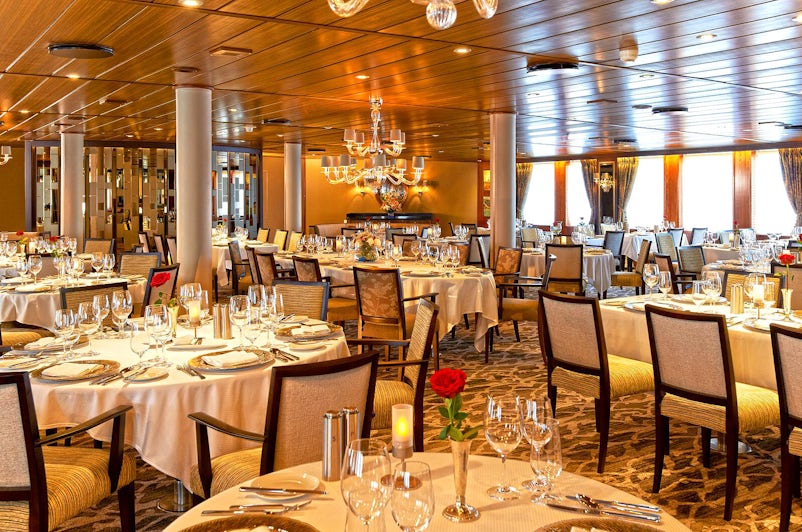
Windstar's Star Breeze follows in the dining traditions of luxury and big-ship cruises; it offers several dining venues, as well as room service. The main AmphorA dining room is chic with mirrored geometric wall designs, coffered ceilings and simple chandeliers. Varied dinner menus offer starters, soups, salads, mains and desserts, and chefs try to incorporate local ingredients when possible. You'll find classic dishes like beef Wellington or duck a l'orange, and the typical cruise mindset of ordering as many appetizers and desserts as you'd like. The indoor-outdoor buffet restaurant serves breakfast and lunch (with menu items available to order), and then turns into a candlelit steakhouse venue for alfresco dinner in an intimate setting.
The dining options on Wind Star are limited to the AmphorA Restaurant, Candles and indoor-outdoor buffet -- and all have a similar look and feel, and menu, as those found on Star Breeze. The biggest difference is Candles is held outside by the pool, rather than in the buffet area. Both ships offer room service, as well as snacks in the Yacht Club throughout the day.
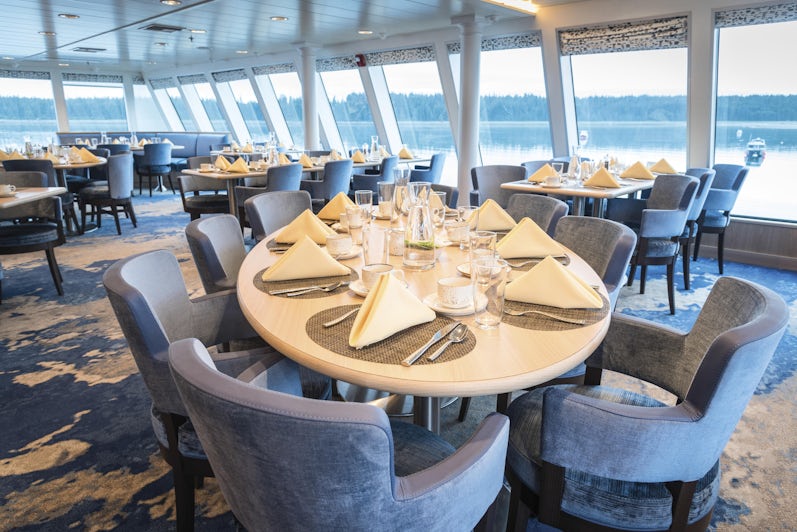
National Geographic Quest has only one dining room, where breakfast, lunch and dinner are served daily. Breakfast and lunch are buffet-style, while dinners are more traditional, with table service. Passengers are asked to sign up for one of three entrees in the morning to avoid food waste.
When possible, the chefs try to source local, seasonal ingredients; food is generally simple but tasty. Hors d'ouevres are served in the lounge during cocktail hour, and bar snacks are available during the day. The ship does not offer room service. The dining room is homey, with big picture windows letting in light. In Costa Rica and Panama, local vendors offer coffee and chocolate tastings onboard.
Choose Windstar if: You're looking for upscale dining and more variety. It's also the line for you if you want a more formal restaurant atmosphere or want to dine only with your travel companions.
Choose Lindblad if: You are content with limited food options and prefer a more laid-back dining atmosphere where you can socialize with other passengers and the expedition leaders.
Pricing and Inclusions

Starting prices for Windstar cruises (ocean-view suites) range from $1,699 to $3,299. Fares include all meals and nonalcoholic beverages, but gratuities, alcohol and shore excursions cost extra.
Fares for Lindblad Expeditions-National Geographic cruises start between $5,990 and $10,490. They include all meals and nonalcoholic beverages, excursions and guides ashore, the expertise of the onboard naturalists and photography instructors, but gratuities and alcohol cost extra. Essentially, it's twice the cost of Windstar (even when you factor in tour prices), though you're getting much smaller cabins and more limited onboard amenities.
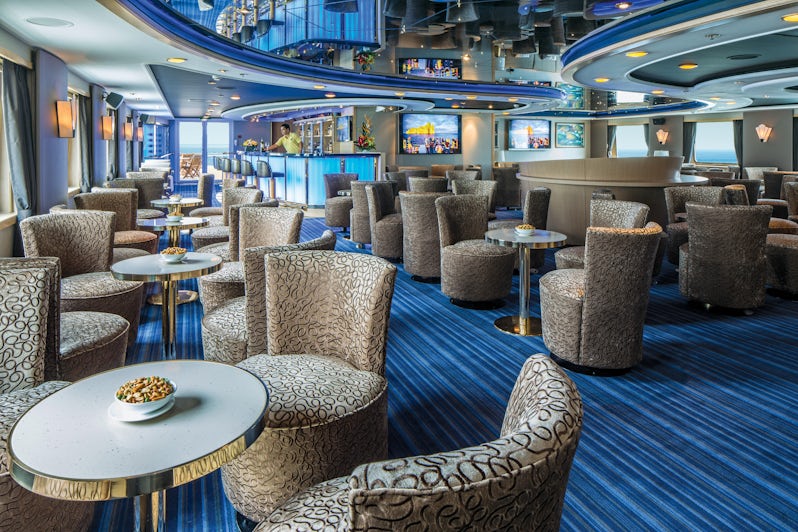
Choose Windstar if: You're looking for a more affordable cruise with luxury touches, but don't mind paying extra for drinks, tours and tips.
Choose Lindblad if: You're willing to pay a premium to sail with a very small number of fellow passengers (Quest is nearly half the size of Star Breeze, and still significantly smaller than Wind Star) and benefit from the expertise of the Natural Geographic naturalists.
Bottom Line
Choose Windstar if: You want to see Costa Rica and Panama in a relaxed, comfortable way. It's the line for you if you like to explore ashore but come back mid-afternoon to spend time in your cabin or the lounge, and you want a bit of entertainment, like listening to live music or playing trivia at night.
Choose Lindblad if: You want an intimate experience with expert guides taking you to nature-based areas, sometimes with exclusive access. It's the line for people who want a journey by water that's not a typical cruise, who don't want to dress up, who prefer exploring ashore to remaining onboard and who can afford to pay for this kind of experience.